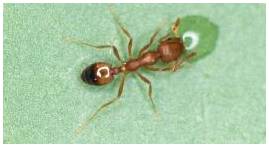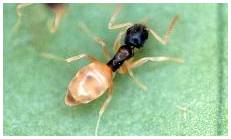Fire Ant
Fire ants build large mounds in open, sunny areas and can forage indoors. Custom Pest Solutions can control these agressive ants, even though the mound is established. Workers are notorious for their painful, burning sting that results in intense itching and a pustule that resembles a painful pimple. Infection may occur if it is broken.
Behavior:
Fire ants are not your average pest; they are capable of causing serious medical, agricultural and property damage. They were most likely introduced to the States via cargo unloaded from ships from South America. Fire ants are distinguished by their aggressive behavior, particularly if their nest/mound is disturbed. When this occurs numerous fire ants will quickly rush out of the mound and attack the intruder.
People unlucky enough to disturb a fire ant colony are seldom stung just once; dozens or even hundreds of stings can be inflicted in a very short time. Some people can have an allergic reaction to fire ant stings that range from rashes and swelling to paralysis or anaphylactic shock. In rare cases, severe allergic reactions can cause death.
Fire ants are omnivorous and will feed on almost any plant or animal matter. Workers will forage for food more than 100 feet from the colony during both the day and night. When a large food source is found, fire ants recruit other workers to help take the food back to the colony.
Habitat:
Fire ants typically nest outdoors in dome-shaped mounds, some up to 4 inches high, or can be found next to or underneath timber, logs, rocks, pavers, bricks, etc. Mounds may not always be evident, but are usually found in open areas such as lawns, pastures, and along roadsides. Single-queen mounds can have up to 250,000 workers and will fight other fire ant colonies, and can result in 40-150 mounds per acre.
Unique Characteristics:
In addition to stinging humans, fire ants can sting pets, livestock, and wildlife. Crop losses are also reported due to fire ants feeding on seedlings and even citrus trees. They will also nest in A/C units and gas and water meter boxes; electrical equipment and utility housings may serve as fire ant nest sites, sometimes resulting in short circuits.
Control:
Due to the overly-aggressive nature of the fire ant and the potential health hazards associated with its sting, we advise immediate pest control measures be taken if any fire ant infestation is discovered.
Repeat applications of pest control chemicals by Custom Pest Solutions' experienced technicians use the safest and most effective way to treat fire ant infestations.
Some think they can be drowned, but fire ant colonies have been known to latch onto floating debris, alive and angry, during serious floods. Also, be sure to watch for visible mounds when mowing your lawn; passing over one will send thousands of stinging ants in all directions.
Pharoh Ant
It usually nests indoors (in wall voids, refrigerator insulation, books, etc.). Once inside, they can be found in wall and cabinets spaces, around insulation, behind baseboards and any other accessible crevices and spaces. They are often found in feeding trails on wiring or hot water pipes, which are used to travel through walls and between floors.
Behavior:
Pharaoh ants tend to feed on sweets, proteins and insects. They forage in set trails along carpets, countertops, cabinets, floors, and baseboards, favoring warm, moist locations in which to nest. Their colonies can become very large with multiple queens; they are also very mobile, with the ability to form new, smaller colonies containing very few ants in a process called "budding”. They can breed continuously throughout the year.
Habitat:
Pharaoh ants can only survive outdoors in sub-tropical areas, where they are often found in leaf litter or rain gutter debris. Pharaoh ants are known for their ability to “get into things”. They have even been observed seeking moisture from the mouths of sleeping newborn infants.
Control:
Pharaoh ants pose a major threat due to their ability to nest indoors in almost every area of a building. Sealing any cracks or holes with caulking is helpful in reducing Pharaoh ant infestation. Setting ant baits in foraging “hot spots” around heated or moist areas works by distributing the poison to the various colonies. Although they have been known to avoid certain pesticides, a baiting regimen by Custom Pest Solutions' technicians over an extended period of time often works best.
Carpenter Ant
Florida carpenter ant has a yellowish-red thorax and black abdomen. It nests in mulch, logs and in wall voids of houses. It can hollow out wood in order to make its nest, depositing wood pieces nearby. Parent carpenter ant colony may establish one or more parent colonies, which contain an egg-laying queen, brood and workers; they also build satellite nests in sound wood that contain large numbers of workers but no queen or larvae. They then may move from an outdoor parent colony to an indoor satellite nest, which does not require moisture since there are no eggs present.
Carpenter ants are omnivorous, and feed on plant juices, fresh fruits, insects (living or dead), meats, syrup, honey, jelly, sugar, grease, fat, honeydew, etc. They feed readily on termites and usually never co-exist with them in a home. Workers are known to forage for food as far as 100 yards from their nest, and have strong jaws which readily bite when contacted.
Habitat:
Outdoors, carpenter ants nest in live and dead trees, rotting logs and stumps, porch pillars and roofs, windowsills and wood in contact with soil. They are also known to live in telephone poles and other man-made structures, and prefer to be close to food sources and safe from environmental hazards such as flooding or heat.
Indoors, they tend to nest in wood, which may be softened by moisture, and in dry wall voids. Workers cut galleries and tunnels in wood, expanding the nest size for the enlarged colony. They have also been found to nest in foam insulation. The presence of 20 or more winged and/or wingless ants indoors is usually a sign of indoor infestation.
Unique Characteristics:
Indoor carpenter ants nest in dry wood, building “galleries” in which the walls are smooth and clean, giving it an almost sandpapered appearance; any debris, such as sawdust-like wood fragments, that is caused by the nest construction is carefully deposited outside the nest. This smooth, clean work often appears as if it were done by carpenters, hence the name.
Control:
Custom Pest Solutions uses baits made specifically for carpenter ants, who carry the bait back to be fed to the ant colony. We recommend you trim all trees and bushes so they do not touch exterior walls. Fix leaky roofs and plumbing to reduce excess moisture; painting and/or sealing wood before it becomes wet is also good. Replace wood previously infested by ants or termites or any rotten or water-damaged wood such as dead stumps, and store wood for later use (firewood, plywood sheets, etc.) off the ground and away from the house.
Ghost Ant ("Sugar Ant")
It usually nests outdoors and forages indoors. The ant has a musty odor when squashed. It has a high need for moisture and is often seen in kitchens and bathrooms.
Behavior:
The Ghost ant is highly adaptable in its nesting habits, nesting readily outdoors or indoors. Colonies may be moderate to large in size containing numerous reproducing females (queens). They have a habit of running rapidly and erratically when disturbed. They are small enough to enter homes through the tiniest holes in caulking or cracks in foundations, or from plants that touch the home. Once inside, they can be seen in kitchens and bathrooms trailing to and from the sinks in search of moisture. They are fond of honeydew and feed on dead and live insects, but once inside they will eat anything sweet (hence the name “sugar ant”, as they are sometimes called).
Habitat:
The Ghost ant is a nuisance ant that is common in Central Florida. It is particularly fond of nesting inside the aluminum supports around screen porches. Once inside your home, it will nest in potted plants and other moist areas, as well as wall voids or spaces between cabinetry and baseboards.
Their colonies are broken into sub-colonies that occupy different nest sites and exchange individuals back and forth along odor trails. The sites include damp grass, plant stems and cavities beneath debris in open, rapidly changing environments. Ghost ants are opportunistic nesters and are often found in places that may remain habitable for only a few days or weeks, and are thus known as a “tramp” ant.
Unique Characteristics:
When they move around on light surfaces, the Ghost ant’s transparent abdomens and legs seem to vanish, leaving just the dark head and thorax visible. On darker surfaces, all you see are pale patches moving about, giving it a “ghostly” appearance.
Control:
Custom Pest Solutions has unique techniques for controlling the Ghost ant. We suggest that you disperse piles of wood, rocks and other debris to discourage nesting sites. Trim landscaping to keep limbs from touching the outside of homes and eliminate excess moisture by repairing leaky roofs, hoses and plumbing. Seal any holes or cracks in exterior walls and foundations. Treating the colonies and sub-colonies directly is suggested since ghost ants usually do not respond to baits.






